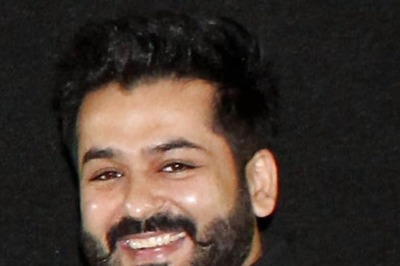
views
Prime Minister Narendra Modi laying the first foundation brick for the Ram temple in Ayodhya on August 5 will usher in a new beginning. A beginning that would mark the first largely non-controversial moment in the epic saga of an issue which had been both one of the lengthiest legal battles in independent India as well as the most-defining political aspect of it. What else but the Ram temple movement and the rising wave of Hindutva had been the most significant reasons behind the BJP’s phenomenal growth. A party with 2 MPs in 1984 has come a long way to now dominate India's political landscape.
This is the story of the political history of an issue and movement around it that redefined national politics from 1980 onward, the period that was ripe with memories of the Emergency and short-lived experiments with the first non-Congress government at the Centre. It was the time when in 1980, the erstwhile Bharatiya Jana Sangh and a section of the Janta Party came together to form a new political entity, the Bharatiya Janata Party.
Since then, the past 40 years have been a roller-coaster ride for the party with a strong nationalistic Hindutva outlook. It’s an era of the BJP’s gradual rise and decline of the Congress at the national level. As the BJP was formed in 1980, the party openly professed its commitment to the cause of the Ram Janmabhoomi agitation. Atal Bihari Vajpayee became its first president.
Even as the newly formed BJP, under a moderate Hindutva face, Vajpayee, had moved on to the stage of pursuing majoritarian Hindu politics, extending support for the long-drawn RSS-led agitation for what it called “liberating the Ram Janmasthan in Ayodhya” where the Babri mosque stood, political dividends were minuscule in the general elections of 1984. The assassination of then Prime Minister Indira Gandhi and the BJP’s mild approach towards Hindutva, both were seen as a cause behind it. The saffron party managed to get just 2 seats in the Lok Sabha that was entirely dominated by the Congress’s 414.
As Indira’s son Rajiv took over as the next prime minister, it was time for the BJP and its mother organisation the RSS to revisit their strategy. Unfazed by electoral adversities, the RSS and BJP decided to throw all their might behind the Ram temple movement. The Congress, despite an overwhelming electoral victory, seemed dwarfed when it came to devising a strategy against this.
As the temple movement gained pace, the Congress party, with the government also in Uttar Pradesh, gave in, paving the way for the opening of the locks at the disputed site in early 1986. A subtle move aimed at catering to the growing Hindu sentiment, it would prove to be a fatal political error as it further galvanised the pro-temple agitation.
The opening of the locks marked a new moment in the temple movement’s history. It was the single biggest development since the night of December 22-23, 1949, when idols of Ram and Lakshman were secretly placed under the central dome of Babri Masjid. The BJP decided to take a full plunge.
In 1989, at its Palampur convention, the party adopted the "liberation of Ram Janmabhoomi and construction of a grand Ram temple at the disputed site” as its core political agenda. The hard-line face of Hindutva, LK Advani, was brought in as the new president of the party. The very next year in 1990, Advani launched his controversial Somnath to Ayodhya Rath Yatra.
The year of Advani’s Rath Yatra, and the one preceding it, were also a lot about political turbulence, both at the Centre as well as in the states of Uttar Pradesh and Bihar. The Congress was in decline. India had VP Singh as prime minister, supported by both the Left and the Right. The party with 2 MPs in 1984 now had 85 members in the Lok Sabha. The Left parties had 45.
In UP, too, it was Mulayam Singh Yadav as chief minister and in Bihar it was Lalu Prasad Yadav. Both were the new faces of social engineering and growing backward caste consciousness arising out of Mandal Commission politics. It was not just the BJP that was to reap the benefits, but also Mulayam and Lalu, in the larger politics around the Ram temple.
While Mulayam got the infamous title of 'Maulana Mulayam' after ordering firing on kar sevaks in Ayodhya in 1990, Lalu created a new political profile by getting Advani arrested in Samastipur, Bihar. Both, thus, carved out a lasting electoral base of Muslims and Yadavs, or the MY factor, which still defines politics in these states to a large extent.
As the build-up around the temple movement increased, the BJP was clearly reaping the political benefits. However, the assassination of former Prime Minister Rajiv Gandhi disturbed its political calculations in the elections for the 10th Lok Sabha in 1991. The party that was headed for a bigger yield was curtailed with just 123 MPs in the Lok Sabha. However, it succeeded in forming its first government in Uttar Pradesh, with Kalyan Singh as chief minister.
With UP under the wings, the stage was all set for a new showdown on the Ram Mandir issue. The climax came on December 6, 1992, when despite the state government’s assurances in the Supreme Court, the mosque was razed in Ayodhya by Hindu zealots. The union government of the Congress led by PV Narasimha Rao was seen as a mere spectator. It was an error that would haunt the Congress for long.
The demolition of Babri Masjid marked a watershed moment in contemporary political history of the country. While the Congress was almost wiped out from states like UP and Bihar, with minorities shifting away from it, a simultaneous blow was also dealt to the BJP in the Hindi heartland as the Hindutva wave subsided a bit, after seeing a dangerous high in the demolition.
The remaining task was done by increasing caste consciousness, Mandal and Dalit politics. Though in subsequent parliamentary elections of 1996 up to 1999, the BJP went on increasing its tally in the Lok Sabha and finally forming its first five-year government at the Centre in 1999, the stage in state politics was dominated more and more by the likes of Mulayam, Mayawati and Lalu Prasad. The genie of Ram temple was out and now entangled in a long-drawn legal battle of title dispute.
As legal proceedings dragged on first in High Court and then in Supreme Court, politics moved beyond the temple issue. From 2004 to 2014, while the Congress-led UPA ruled the nation, the BJP seemed to be in troubled waters. In 2014, when the BJP recovered lost ground under Narendra Modi’s leadership, Ram temple was more a footnote of the party's commitment.
Though Modi successfully modeled and projected himself as the staunch new poster boy of radical Hindutva, he chose to keep a distance from Ayodhya and Ram temple. Never as PM did he visit the holy city. On occasions, he did say, “The way for Ram temple will come through the courts.”
Finally, with the Supreme Court ruling in favour of the temple in its 2019 decision, the long-drawn legal battle and political movement around it came to an end. Now, as Prime Minister Modi is all set to visit Ayodhya on August 5, to lay the first brick for the foundation of the Ram temple, a new kind of politics is likely to emerge. A politics beyond “agitation for Ram Mandir”. A politics that will be taken to the people’s court by the BJP as a long-standing electoral promise that has finally been delivered.
(This story is Part 1 of a series on Ayodhya's Ram Temple which is set for a grand 'Bhoomi Poojan' on August 5)




















Comments
0 comment